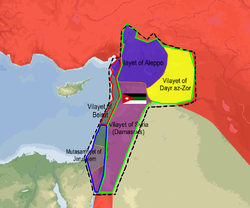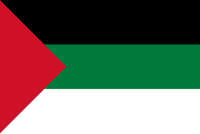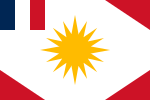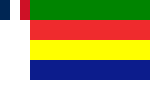Mandate for Syria and the Lebanon
French Mandate for Syria and the Lebanon Mandat français en Syrie | |||||||||||||
|---|---|---|---|---|---|---|---|---|---|---|---|---|---|
| 1920–1946 | |||||||||||||
|
Flag of the French Mandate of Syria (1920-1922) | |||||||||||||
| Location of Syria | |||||||||||||
| Status | Mandate of France | ||||||||||||
| Capital | Damascus | ||||||||||||
| Common languages | Arabic, French | ||||||||||||
| Historical era | Interwar period | ||||||||||||
• Mandate granted | April 25, 1920 1920 | ||||||||||||
| July 23, 1920 | |||||||||||||
• Federation established | June, 1922 | ||||||||||||
| December 1, 1924 | |||||||||||||
| March-September, 1936 | |||||||||||||
| April 17, 1946 1946 | |||||||||||||
| ISO 3166 code | SY | ||||||||||||
| |||||||||||||
The French Mandate for Syria and the Lebanon (originally the French Mandate of Syria, renamed officially in 1922) was a League of Nations mandate created after the First World War and the partitioning of the Ottoman Empire. During the two years that followed the end of the war in 1918, and according to the Sykes-Picot Agreement which was signed between Britain and France during the war, the British held control of the Ottoman province of Mesopotamia (Iraq) and the southern part of the Ottoman province of Syria (Palestine and Jordan), while the French controlled the rest of Ottoman Syria (modern Syria, Lebanon, and Hatay province of Turkey).
During the first years of the 1920s, the British and French control of these territories became formalized by the League of Nations' mandate system, and France was assigned the mandate of Syria in September 29, 1923, which included modern Lebanon and Hatay (Alexandretta) in addition to modern Syria.
The French mandate of Syria lasted until 1943, when two independent countries emerged from the mandate period, Syria and Lebanon, in addition to Hatay which had joined Turkey in 1939 following a referendum. French troops left Syria and Lebanon finally in 1946.
The Arab Kingdom of Syria
With the defeat of Ottomans in Syria, British troops under Marshal Edmund Henry Allenby entered Damascus in 1918 accompanied by troops of the Arab Revolt led by Faisal, son of Sharif Hussein of Mecca.
Faisal established the first Arab government in Damascus in October 1918, and named Ali Rida Pasha ar-Rikabi a military governor.

The new Arab administration formed local governments in the major Syrian cities, and the Pan-Arab flag was raised all over Syria. The Arabs hoped, with faith in earlier British promises, that the new Arab state would include all the Arab lands stretching from Aleppo in northern Syria to Aden in southern Yemen.

However, General Allenby, and in accordance with the secret Sykes-Picot Agreement between Britain and France, assigned to the Arab administration only the interior regions of Syria (the eastern zone). Palestine (the southern zone) was reserved for the British, and on October 8, French troops disembarked in Beirut and occupied all the Lebanese coastal region until Naqoura (the western zone) replacing British troops there. The French immediately dissolved the local Arab governments in the region.
The French demanded full implementation of the Sykes–Picot Agreement and the placement of Syria under their influence. On November 26, 1919, the British withdrew from Damascus to avoid confrontation with the French, leaving the Arab government face to face with the French.
Faisal had voyaged several times in Europe, beginning in November 1918, trying to convince Paris and London to change their positions, but without success. Signifying the determination of France on its intervention in Syria was the naming of General Henri Gouraud as a high commissioner in Syria-Cilicia.
At the Paris Peace Conference, Faisal found himself in an even weaker position when the European powers decided to ignore the Arab demands.
In June 1919, the American King-Crane Commission arrived in Syria to inquire about the local public opinion regarding the future of the country. The commission's workspace extended from Aleppo to Beersheba. They visited 36 major cities, met with over than 2000 delegations from more than 300 villages, and received more than 3000 petitions. Their conclusions confirmed the opposition of Syrians to the mandate in their country as well as to the Balfour declaration, and their demand of a unified Greater Syria encompassing Palestine. The conclusions of the commission were rejected by France and ignored by Britain.
In May 1919, elections were held for the Syrian National Congress. 80% of seats went to conservatives. However, the minority included dynamic Arab nationalist figures such as Jamil Mardam-Bey, Shukri al-Kuwatli, Ahmad al-Qadri, Ibrahim Hanano, and Riyad as-Solh.
Unrest erupted in Syria when Faisal accepted a compromise with the French Prime Minister Clemenceau and with the Zionist leader Weizmann over the issue of Jewish immigration to Palestine. Anti-Hashemite manifestations broke out, and Muslim inhabitants in and around Mount Lebanon revolted with fear of being incorporated into a new, mainly Christian, state of Greater Lebanon.


In March 1920, the Syrian national congress in Damascus, headed by Hashim al-Atassi, adopted a resolution rejecting the Faisal-Clemenceau accords. The congress declared the independence of Syria in her natural borders (including Palestine), and proclaimed Faisal the king of Arabs. The congress also proclaimed political and economic union with neighboring Iraq and demanded its independence as well. A new government headed by Ali Rida ar-Rikabi was formed on May 9, 1920.
On April 25, and in the course of the Treaty of Sevres, the supreme inter-allied council granted France the mandate of Syria (including Lebanon), and granted the UK the mandate of Palestine (including Jordan) and Iraq. Syrians reacted with violent demonstrations, and with the formation of a new government under Hashim al-Atassi on May 7, 1920. The new government decided to organize general conscription and began financing an army.

These decisions provoked adverse reactions by the French as well as by the Maronite patriarchate of Mount Lebanon, which denounced the decisions as a "coup d'état." In Beirut, the Christian press expressed its hostility to the decisions of Faisal's government. Lebanese nationalists profited of the crisis to convene a council of Christian figures in Baabda on March 22, 1920, that proclaimed the independence of Lebanon.

On July 14, 1920, General Gouraud issued an ultimatum to Faisal giving him the choice between submission or abdication. Realizing that the power balance was not in his favor, Faisal chose to cooperate. However, the young minister of war, Youssef al-Azmeh, refused to comply and, during the Franco-Syrian War faced the French at the Battle of Maysaloun. This battle was won by the French under General Mariano Goybet in less than a day and Azmeh died on the battlefield along with most of those who were with him. General Goybet entered Damascus on July 24, 1920.
When first arriving in Lebanon, the French were received as liberators by the Christian community, but as they were entering Syria they were faced with a strong resistance. It took France three years from 1920 to 1923 to hold full control over Syria and to quell all the insurgencies that broke out, notably in the Alawite territories, Mount Druze and Aleppo.
The Mandate
Following the San Remo conference and the defeat of King Faisal's short-lived monarchy in Syria at the Battle of Maysalun, the French general Henri Gouraud subdivided the mandate of Syria into six states. They were the states of Damascus (1920), Aleppo (1920), Alawites (1920), Jabal Druze (1921), the autonomous Sanjak of Alexandretta (1921) (modern-day Hatay), and the State of Greater Lebanon (1920) which became later the modern country of Lebanon.

In July 1922, France established a loose federation between three of the states: Damascus, Aleppo, and the Alawite under the name of the Syrian Federation (Fédération syrienne). Jabal Druze, Sanjak of Alexandretta, and Greater Lebanon were not parts of this federation, which adopted a new federal flag (green-white-green with French canton). On December 1, 1924, the Alawite state seceded from the federation when the states of Aleppo and Damascus were united into the State of Syria.
In 1925, a revolt in Jabal Druze led by Sultan Pasha el Atrash spread to other Syrian states and became a general rebellion in Syria. France tried to retaliate by having the parliament of Aleppo declare secession from the union with Damascus, but the voting was foiled by Syrian patriots.

On May 14, 1930, the State of Syria was declared the Republic of Syria and a new constitution was drafted. Two years later, in 1932, a new flag for the republic was adopted. The flag carried three red stars that represented the three districts of the republic (Damascus, Aleppo, and Deir ez Zor).
In 1936, the Franco-Syrian Treaty of Independence was signed, a treaty that would not be ratified by the French legislature. However, the treaty allowed Jabal Druze, the Alawite (now called Latakia), and Alexandretta to be incorporated into the Syrian republic within the following two years. Greater Lebanon (now the Lebanese Republic) was the only state that did not join the Syrian Republic. Hashim al-Atassi, who was Prime Minister under King Faisal's brief reign (1918–1920), was the first president to be elected under a new constitution adopted after the independence treaty.
In September 1938, France again separated the Syrian district of Alexandretta and transformed it into the Republic of Hatay. The Republic of Hatay joined Turkey in the following year, in June 1939. Syria did not recognize the incorporation of Hatay into Turkey and the issue is still disputed until the present time.
With the fall of France in 1940 during World War II, Syria came under the control of the Vichy Government until the British and Free French invaded and occupied the country in July 1941. Syria proclaimed its independence again in 1941 but it wasn't until January 1, 1944, that it was recognized as an independent republic.
On May 29, 1945, France bombed Damascus and tried to arrest its democratically elected leaders. While French planes were bombing Damascus, Prime Minister Faris al-Khoury was at the founding conference of the United Nations in San Francisco, presenting Syria’s claim for independence from the French Mandate. Continuing pressure from Syrian nationalist groups and British pressure forced the French to evacuate their last troops in April 17, 1946.
In the 1940s, Britain secretly advocated the creation of a Greater Syrian state that would secure Britain preferential status in military, economic and cultural matters, in return for putting a complete halt to Jewish ambition in Palestine. France and the United states opposed British hegemony in the region, which eventually lead to the creation of Israel.[1]
Post World War II status and the founding of the UN
On September 27, 1941 France proclaimed, by virtue of, and within the framework of the Mandate, the independence and sovereignty of the Syrian State. The proclamation said "the independence and sovereignty of Syria and Lebanon will not affect the juridical situation as it results from the Mandate Act. Indeed, this situation could be changed only with the agreement of the Council of the League of Nations, with the consent of the Government of the United States, a signatory of the Franco-American Convention of April 4, 1924, and only after the conclusion between the French Government and the Syrian and Lebanese Governments of treaties duly ratified in accordance with the laws of the French Republic.[2]
Benqt Broms said that it was important to note that there were several founding members of the United Nations whose statehood was doubtful at the time of the San Francisco Conference and that the Government of France still considered Syria and Lebanon to be mandates.[3]
Duncan Hall said "Thus, the Syrian mandate may be said to have been terminated without any formal action on the part of the League or its successor. The mandate was terminated by the declaration of the mandatory power, and of the new states themselves, of their independence, followed by a process of piecemeal unconditional recognition by other powers, culminating in formal admission to the United Nations. Article 78 of the Charter ended the status of tutelage for any member state: 'The trusteeship system shall not apply to territories which have become Members of the United Nations, relationship among which shall be based on respect for the principle of sovereign equality.'"[4]
States created during the French Mandate
During the French mandate, several states were created in the once united Greater Syria. The drawing of those states was based primarily on exploiting the diverse sectarian make up of Syria. However, nearly all the Syrian sects were hostile to the French mandate and to the division it created. This was best demonstrated by the numerosity of revolts that the French encountered in all of the Syrian states.
Maronite Christians of Mount Lebanon, on the other hand, were a community with a dream of independence that was being realized under the French; therefore, Lebanon was the exception between the newly formed states.
State of Greater Lebanon

On September 1, 1920, General Gouraud proclaimed the establishment of the State of Greater Lebanon (French: État de Grand Liban) (Arabic: دولة لبنان الكبير).
Greater Lebanon was created by France to be a "safe haven" for the Maronite population of the Mutasarrifia (Ottoman administrative unit) of Mount Lebanon. Mt. Lebanon, an area with a Maronite majority, had enjoyed variable degrees of unofficial autonomy during the Ottoman era. However, Greater Lebanon included in addition to Mount Lebanon other mainly Muslim regions that were not part of the Maronite Mutasarrifia, and hence the word "greater." Those regions correspond today to north Lebanon, south Lebanon, Biqa' valley, and Beirut.
The capital of Greater Lebanon was Beirut. The new state was granted a flag merging the French flag with the cedar of Mt. Lebanon.
Muslims in Greater Lebanon rejected the new state upon its creation. They boycotted the general census in 1922, and refused to receive new identity cards before General Gouraud agreed to remove from the cards the part stating the Lebanese citizenship. The Muslim continuous demand for reunification with Syria eventually brought about an armed conflict between Muslims and Christians in 1958 when Muslim Lebanese wanted to join the newly proclaimed United Arab Republic, while Christians were strongly opposed to that.
Although most of the Lebanese sects were not enthusiastic for the new state, Maronites were the majority and they managed to preserve its independence; an independence that created a unique precedent in the Arab world as Lebanon was the first Arab country in which Christians were not a minority.
The State of Greater Lebanon existed until May 23, 1926, after which it became the Lebanese Republic.
State of Alawites

The State of Alawites (French: État des Alaouites) (Arabic: دولة العلويين) was located on the Syrian coast and incorporated a majority of Alawites, a branch of Shia Islam. The port city of Latakia was the capital of this state.
Initially it was an autonomous territory under French rule known as the Alawite Territories. It became part of the Syrian Federation in 1922, but left the federation again in 1924 and became the State of Alawites. On September 22, 1930, it was renamed the Independent Government of Latakia. The population at this time was 278,000. The government of Latakia finally joined the Syrian Republic on December 5, 1936.
This state witnessed several rebellions against the French. The most prominent of which were under Salih al-Ali, an Alawite anti-French figure.
State of Jabal Druze

Jabal Druze was a French mandate from 1921 to 1936 created for the Druze population of southern Syria. It had a population of some 50,000 and had its capital in As Suwayda.
State of Aleppo

The State of Aleppo (1920–1925) (French: État d'Alep) (Arabic: دولة حلب) included a majority of Sunni Muslims. It covered northern Syria in addition to the entire fertile basin of river Euphrates of eastern Syria. These regions represented much of the agricultural and mineral wealth of Syria. The autonomous Sanjak of Alexandretta was added to the state of Aleppo in 1923.
The capital was the northern city of Aleppo, which had large Christian and Jewish communities in addition to the Sunni Muslims. The state also incorporated minorities of Shiites and Alawites. Ethnic Kurds, Syriacs, and Assyrians inhabited the eastern regions alongside the Arabs.
The primarily Sunni population of the state of Aleppo was strongly opposed to the division of Syria. This resulted in its quick end in 1925, when France united the states of Aleppo and Damascus into the State of Syria.
State of Damascus

The State of Damascus was a French mandate from 1920 to 1925. The capital was Damascus.
Sanjak of Alexandretta
The Sanjak of Alexandretta was autonomous from 1921 to 1923, under the French-Turkish treaty of October 20, 1921, due to the presence of an important Turkish community along with Arabs of various religious denominations: Sunni Muslims, Alawites, Syriac Orthodox, Greek Orthodox, Greek Catholics, Maronites. There were also communities of Jews, Assyrians, Kurds, Armenians and Greeks. In 1923 Alexandretta was attached to the State of Aleppo, and in 1925 it was directly attached to the French mandate of Syria, still with special administrative status.
The 1936 elections in the sanjak returned two MPs favoring the independence of Syria from France, and this prompted communal riots as well as passionate articles in the Turkish and Syrian press. This then became the subject of a complaint to the League of Nations by the Turkish government under Mustafa Kemal Atatürk concerning alleged mistreatment of the area's Turkish populations. Atatürk demanded that Alexandretta become part of Turkey, claiming that the majority of its inhabitants were Turks. The sanjak was given autonomy in November 1937 in an arrangement brokered by the League. Under its new statute, the sanjak became 'distinct but not separated' from the French Mandate of Syria on the diplomatic level, linked to both France and Turkey for defence matters.
The allocation of seats in the sanjak assembly was based on the 1938 census held by the French authorities under international supervision: out of 40 seats, 22 were given to the Turks, nine for Alawi Arabs, five for Armenians, two for Sunni Arabs, and two for Christian Arabs. The assembly was appointed in the summer of 1938 and the French-Turkish treaty settling the status of the Sanjak was signed on July 4, 1938.
On September 2, 1938, the assembly proclaimed the Sanjak of Alexandretta as the Republic of Hatay, taking as an excuse that rioting had broken out between Turks and Arabs.[citation needed] The Republic lasted for one year under joint French and Turkish military supervision. The name "Hatay" itself was proposed by Atatürk and the government was under Turkish control. The president Tayfur Sökmen was a member of Turkish parliament elected in 1935 (representing Antakya (Greek: Αττάλεια)) and the prime minister Dr. Abdurrahman Melek, was also elected to the Turkish parliament (representing Gaziantep) in 1939 while still holding the prime-ministerial post.
In 1939, following a popular referandum, the Republic of Hatay became a Turkish province.
See also
References
This article includes a list of references, related reading, or external links, but its sources remain unclear because it lacks inline citations. (April 2009) |
- Mandat Syria-Liban ... (1920-146)
- La Syrie et le mandat français (1920-1946)
- Les Relations franco-libanaises dans le cadre des relations Internationales
- Mandat français au Proche-Orient
- ^ https://www.haaretz.co.il/hasen/spages/950373.html
- ^ See Foreign relations of the United States diplomatic papers, 1941. The British Commonwealth; the Near East and Africa Volume III (1941), pages 809-810; and Statement of General de Gaulle of November 29, 1941, concerning the Mandate for Syria and Lebanon, Marjorie M. Whiteman, Digest of International Law, vol. 1 (Washington, DC: U. S. Government Printing Office, 1963) 680-681
- ^ See International law: achievements and prospects, by Mohammed Bedjaoui, UNESCO, Martinus Nijhoff; 1991, ISBN 9231027166, page 46 [1]
- ^ Mandates, Dependencies and Trusteeship, by H. Duncan Hall, Carnegie Endowment, 1948, pages 265-266
External references
- "No Yo-Yo!". Time Magazine. January 30, 1933. Retrieved August 19, 2009.


